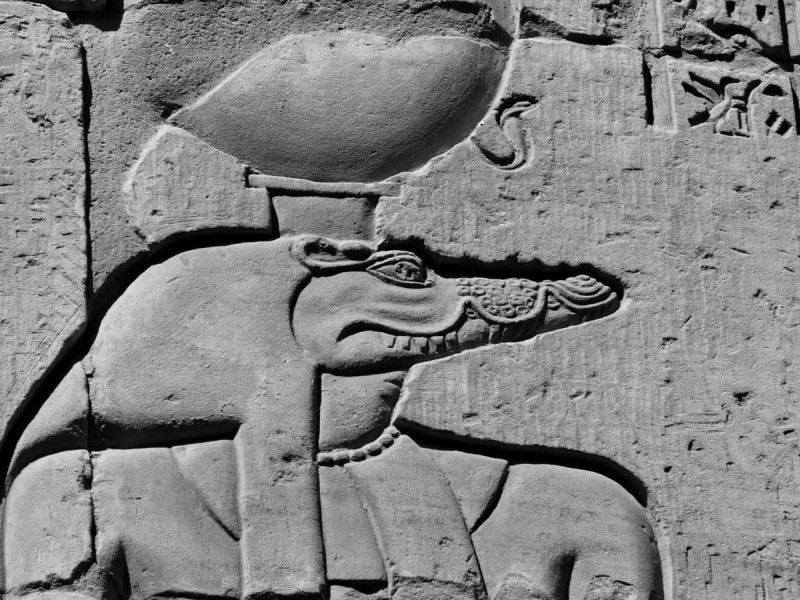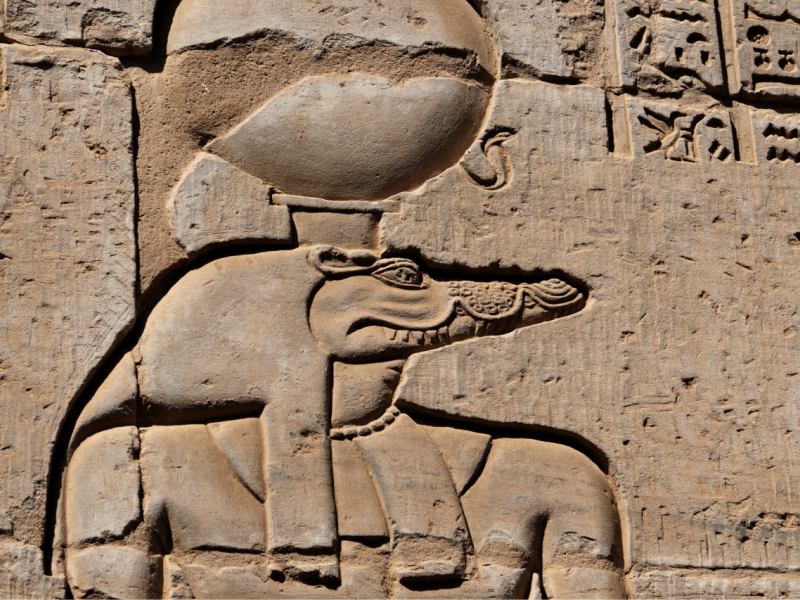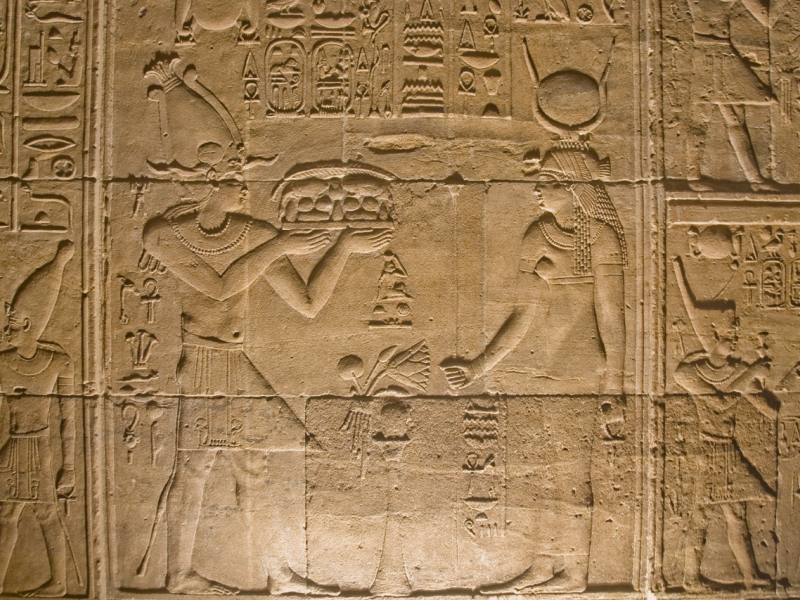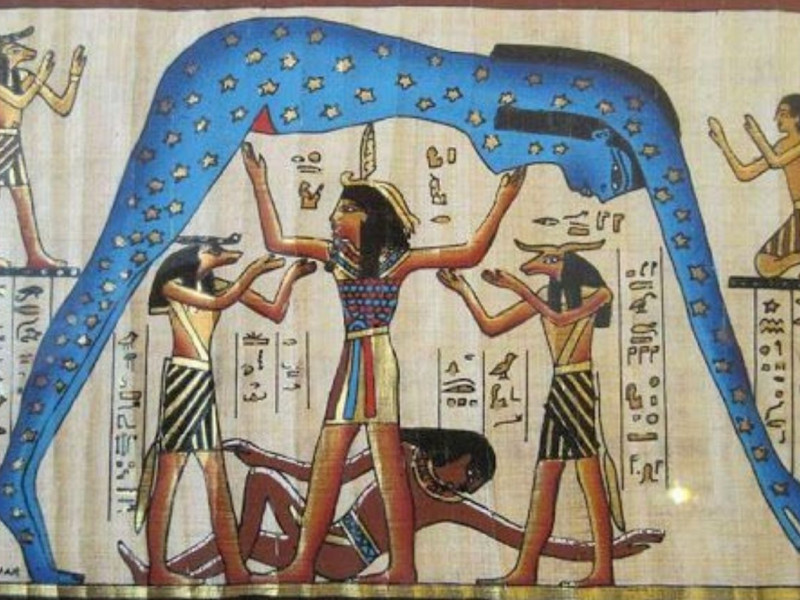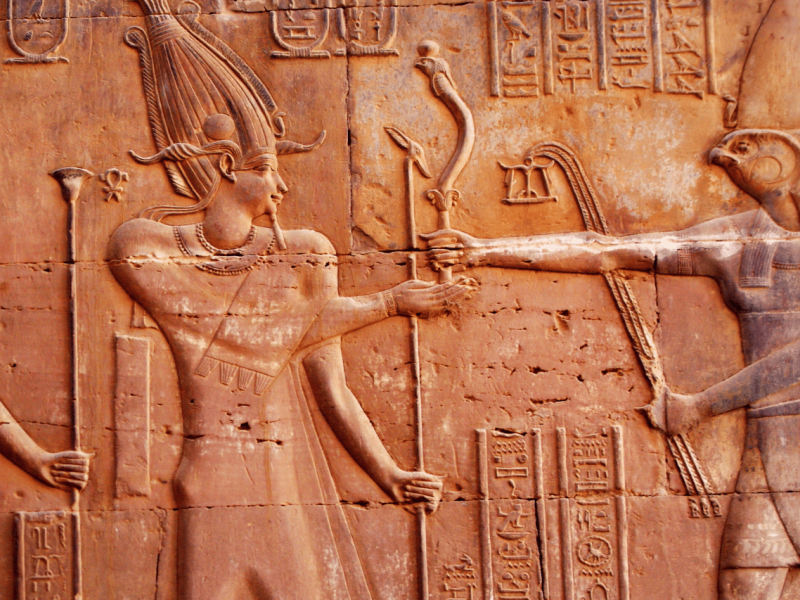Seth
The story of Seth, the Egyptian god of chaos, is an interesting one. Though it was not unusual in ancient mythologies for a god to be fallible or even evil, few gods made such an abrupt and complete change from one nature to another.
In Ancient Egypt, the people valued ma’at above all else. Ma’at was the natural order of the universe, which included themes of truth, harmony, order, and most importantly, balance. For balance to be achieved, the natural order depended on the concept of duality. To the Egyptians, everything had its antithesis, and the gods were no exception.
Seth was called upon to serve as the antithesis of several other gods in different ways. Unfortunately, Seth already possessed a well-established persona based on positive attributes. In Upper Egypt, he was readily worshipped as a benevolent god. Why was Seth required to change so drastically? How did he become the “bad guy” for the Egyptian pantheon? Let’s examine his story in full and see if we can understand the motive and process of this god’s epic downfall.
Who Is Seth in Egyptian Mythology?
Since Seth changed his alignment halfway through his history, it is difficult to thoroughly explain his attributes without confusion. For the sake of clarity, this section will describe Seth in his later, more sinister form. Early information is covered later.
Also known as Set and Sutekh, the ancient Egyptian god Seth was considered the god of chaos, storms, earthquakes, droughts, and other disruptions to the normal order. His name usually translates as destroyer or bringer of confusion. He is also associated with foreign lands, deserts, and the color red. The Egyptian word for desert is dshrt, which means the red place.
With these attributes, he served as the antithesis of three different gods:
Horus: god of the sky and daytime vs. Seth: god of land and night
Osiris: god of vegetation and fertile soil vs. Seth: god of deserts and drought
Ra: god of order and light vs. Seth: god of chaos and darkness
This antithesis was considered vital to the dualistic nature of the Egyptian belief system. Good cannot be good without evil. Therefore Seth’s role as the “bad guy” was as important as that of the “good guys” he opposed.
Physically, Seth resembled the other anthropomorphic Egyptian gods; he wore the body of a man and the head of an animal. In Seth’s case, however, no one was sure what the animal was! The body was canine in nature, with a thin, pointed snout, tall, rectangular ears, and a forked tail. The mysterious animal came to be known as the sha. Since Seth wore its head, it was sometimes called the “Seth animal.” Many scholars believe it was a fictional beast explicitly invented to represent the Seth deity.
Seth occasionally took the complete form of the sha and other animals as well. The list of possible animals was lengthy, and it included the boar, the antelope, the crocodile, the fish, the ass, and the hippopotamus. He was often affiliated with the snake due to his interactions with Apep, the serpent of chaos.
The existing images of Seth show him holding an ankh in one hand and a was-sceptre in the other. The was-sceptre was a staff with a sha at the top and a forked base.
Being a god of foreign lands, Seth was adopted by the Hyksos, an Asiatic tribe, when they conquered Lower Egypt during the Second Intermediate Period. They associated him with their chief god, Baal, who was a storm god. During that time, he was connected as a consort to two of their goddesses, Anat and Astarte.
Seth is likely the inspiration for the Judeo-Christian representation of Satan. His association with Apep the serpent evokes images of the serpent in the Garden of Eden. Also, Jesus was tempted by Satan in the desert, the realm of Seth.
The Creation of Seth and the Egyptian Gods
In the beginning, there was an amorphous sea of nothingness. As biblical scripture noted a thousand years later, “The Earth was without form, and void, and darkness was upon the face of the deep.” Some said this void was actually eight “water gods,” which dealt less with water and more with formlessness, hiddenness, and chaos.
Then rose Amun, the self-born, standing atop the primordial hill. From the nothingness of the void, Amun created two children: Shu (Air) and Tefnut (Water). They, in turn, had two children, Geb (Earth) and Nut (Sky). Geb and Nut gave birth to the five central figures in Egyptian mythology.
Osiris, god of fertile soil and vegetation
Isis, goddess of life and magic
Seth, god of chaos and disruption
Nephthys, goddess of death and darkness
Horus (the Elder), god of the skies and daytime
Myths added later in dynastic history suggest that Seth’s aberrant tendencies began at birth. It was recorded in the Pyramid texts that, rather than undergoing normal childbirth, he ripped himself from his mother’s womb. Other sources suggest that Nut spat him into existence.
Seth formed an attachment to Nephthys before their birth, and the two siblings married. Their unhappiness in marriage served as the dualistic antithesis of the blissful union of Osiris and Isis. Though Seth had many affairs, he remained as barren as the desert. He was rumored to be bisexual.
Seth’s Early History as Benevolent Lord of Upper Egypt
In the Pre-Dynastic era, Ancient Egypt was divided into “The Two Lands.” They were named according to the direction of the Nile rather than by the natural compass. Therefore, Upper Egypt was in the South, and Lower Egypt lay in the North. For some time after unification, the regions retained their own symbols, rituals, and even gods.
In the earliest versions of the myths, Seth was the lord of Upper Egypt, while Horus the Elder presided over Lower Egypt. Seth was also master of the deserts and barren lands beyond Egypt’s borders. At that time, Seth was viewed as a benevolent god, and there were several temples honoring him. He was initially worshiped in a desert settlement called Nubt, near the desert lands where gold was mined. Thus, he was occasionally called “He of Gold Town.”
His main cult center was in Ombos, where petitioners asked the priests for assistance with many facets of daily life. They invoked Seth’s name in matters of the heart and inscribed his name on amulets as love charms. The temple there was ruined in antiquity, but an archaeological dig uncovered a huge was-sceptre, the largest object made of faience ever found in Egypt. The was-sceptre belonged to Amenhotep III, who dedicated the object to Seth.
As the god of deserts, Seth also protected the oases, which were vital to survival. He also befriended the dead and allowed them to use his ladder to climb to heaven and the afterlife.
The idea of Seth and Ra as allies likely stems from this era in Seth’s history. It was believed that he rode the sun-boat with Ra every day to protect him from Apep, the god of chaos. Apep, or Apophis in later texts, was an enormous serpent who sought to devour the sun. Seth rode in the prow of the sun-boat and defended Ra by fighting off Apep with a spear. In some texts, Apep hypnotized Ra and swallowed the sun each night, and Seth cut the serpent open with the spear to release the sun back into the sky.
Seth and Horus: The Unification of Upper and Lower Egypt
During the Old and Middle Kingdom periods, Horus the Elder and Seth were viewed as the god-rulers of Lower and Upper Egypt, each of equal status and strength. Sometimes they were even perceived as allies and embodied a two-headed persona called Horus-Set.
Though they fought each other for supremacy, one could not best the other, so they seemed destined to fight until the end of time. In a way, this ineffectual struggle was a personification of the balance of ma’at.
Since the battle of Horus and Seth mirrored the corresponding struggles of humankind, a new part of the myth was required when Egypt finally became a unified country. Upper Egypt lost the seat of power to Lower Egypt; therefore, Seth needed to lose his battle with Horus. Here is where Seth began to shift from a benevolent, courteous god to one consumed by petty jealousies and nefarious deeds in the struggle for power.
Interestingly, the creation of this myth predates the widespread use of the Osiris myth, in which Seth’s evil nature is fully on display. This explains the confusing shifts in Seth’s persona and the conflation of Horus the Elder and Horus the Younger.
The Rule of Osiris and the Jealousy of Seth
Regardless of the order of the myths, the story of Osiris and Seth may be the most well-recognized Egyptian myth. It shapes the form and function of many of the Egyptian gods and cements Seth’s role as the primary evil villain in the Egyptian pantheon. However, no Egyptian text recounts the entire myth, and sources vary widely in their account.
Soon after the creation myth, Nut’s eldest son, Osiris, became the ruler of the world. He married his sister, Isis, and reigned over a peaceful and prosperous Egypt. He gave the uncivilized Egyptian people instructions on law and order, agricultural methods, and religious structure, and their civilization thrived.
Seth, however, was not so content. He was jealous of his brother’s popularity and power. He felt that he was just as capable of ruling as Osiris, who only gained the throne because he was born first. One day, Osiris decided to tour the rest of the world and civilize other groups of humans. Instead of leaving Seth to rule Egypt in his place, Osiris appointed Isis as Regent. Seth considered this a grave insult.
Also, he envied his brother’s happy marriage. Nephthys was displeased by Set’s appearance and his inability to give her children. One day, she disguised herself as Isis and seduced Osiris. Due to this union, she gave birth to Anubis. Seth was furious and vowed revenge.
Seth’s First Wicked Deed and the Death of Osiris
When Osiris returned from his travels, Seth threw a grand party. At the height of the festivities, Seth revealed a beautiful sarcophagus made of cedar and ebony, and he announced that the person who fit the coffin perfectly could have it as a gift.
As planned, none of the other attendees fit. When Osiris stepped into the sarcophagus, Seth slammed down the lid, sealed it shut, and threw the box into the Nile river. Some sources record that Seth did all of this by himself, while others mention that he had 72 helpers.
The sarcophagus floated down the Nile and out to sea, and it finally washed up near the city of Byblos in Phoenicia. It lodged in a tamarisk tree, and the tree grew around the coffin until it disappeared from view. One day, Malcander, the King of Byblos, was out walking with his wife, Queen Astarte, and he noticed the magnificent, fragrant tree. He ordered it cut down and made into a beautiful ornamental pillar for his court.
The Faithfulness of Isis and Seth’s Second Wicked Deed
Isis journeyed from Egypt to find her husband. She finally tracked him to Byblos, where she disguised herself as an older woman and offered herself as nursemaid to Malcander’s sons.
She became fond of the younger son, Dictys, and decided to make him immortal by burning away his human qualities with magical fire. When Queen Astarte saw their nursemaid placing her child in flames, she screamed. Startled, Isis dropped her disguise and revealed her true identity. The King and Queen offered Isis anything she wanted, and Isis requested the pillar.
Isis freed Osiris from the pillar, but of course, he was long since dead. She brought his body back to the fertile marshes of the Nile delta and brought him back to life just long enough for him to father a child. Many sources suggest that only his penis was reanimated during this process. Either way, Isis gave birth to Horus, also called Horus the Younger.
Leaving Nephthys to keep watch over Osiris’ body, Isis took the infant Horus to be nursed by the cobra goddess Wadjet, “she who is green.” While she was gone, the sinister Seth tricked Nephthys into revealing where the body was hidden. Seth found the dead Osiris and cut him into 14 pieces, flinging them in all directions.
When Isis returned, Nephthys tearfully told her what happened. Together, the two sisters searched and recovered 13 of the body parts. Sadly, Osiris’ penis had been devoured by the oxyrhynchus fish. Ancient Egyptians were thereafter forbidden to consume that fish.
Ra took pity on Isis and brought her husband back to life, but since Osiris was no longer whole, he could not rule as before. Anubis performed the first mummification, wrapping his body in linen strips. Then, Osiris went to the underworld to become the Lord of the dead.
The Final Battle Between Seth and Horus
For the next several years, Isis hid the young Horus in the delta marshes. Seth searched for the boy to kill him but was unsuccessful. When Horus was grown, he battled Seth and drove him out of Egypt, or according to some sources, Horus killed Seth. One Egyptian manuscript from the 20th Dynasty demotes their conflict to a legal battle.
Known as The Contendings of Horus and Set, uncle and nephew presented their cases to the nine Egyptian gods known as the Ennead. The judges required them to compete in contests and battles, which Horus eventually won. Horus damaged Seth’s testicles during the struggle, and Seth ripped off one of Horus’ eyes. The Eye of Horus became a significant symbol in Egyptian mythology.
Conclusion
Because of the dualistic nature of Egyptian mythology, Seth, in his darker persona, was not reviled or hated but was viewed as a “necessary evil.” Plus, his fall from grace allowed him to be a primary player in several of the most formative and remembered Egyptian myths. Here’s what we covered about this god of Chaos.
Seth was one of the five Osirian gods.
In his final form, he was the god of chaos, storms, the desert, and drought.
He was the primary god of Upper Egypt during the Pre-Dynastic Period.
He defended the sun god Ra from the serpent of chaos.
He was changed from a benevolent god to an evil one to help balance the Egyptians’ ideas of harmony in duality.
He served as the antithesis of Osiris, Ra, and Horus.
His main symbols were the sha, or Seth animal, and the was-sceptre.
Though he had several wives and concubines, he had no children.
He killed Osiris and later hacked his body into 14 pieces.
He was defeated by both Horus the Elder and Horus the younger.
Exactly why Seth experienced an abrupt change of personality is unknown. Perhaps new myths were needed to explain the history of a unified Egypt. Or, he was “guilty by association” when his followers fell from power. Regardless of the reason, Seth continued to be a vital player in Egyptian mythology and remains a fascinating subject for study.
By Jimmy Joe





